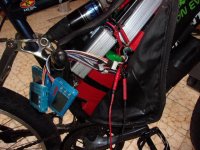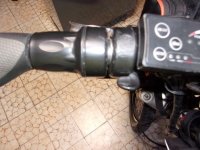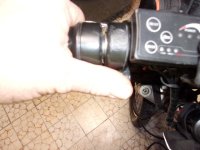PWD-
I like your choice of a bike, color too! Were you looking for a nice big, open triangle or just being patriotic?
I luv my 2003 Edge. It's basicly out-fitted w/ the same components as a '05 Element 30, but w/ 130mm Bombers and 4.75" Float R;

The way I got it is kinda funny. In 2010, I was in this huge bicycle "superstore" looking for a bike for my first build when I spied this bike all dusty sitting in the corner and asked the salesperson about it. "Oh, it had been lost in the warehouse, we just found it." I offered them a $1000 and they took it.
It's a XL (20.5") frame, and while that is great for packing in the batteries, I couldn't straddle the top tube w/out it intruding into my,....personal space. So I laced up some 24"(wider)wheels, but then I would get pedal strikes in the corners. Eventually, I replaced the crank-set w/ one that came w/ a 50T chain ring and shorter crank arms.
The bike has been "solid as a rock", and the only non ebike things I've had to do revolved around the shock. The seals had dried-up from sitting for 7 years and I put a rebuild kit in(super easy)and while I was at it, i installed a Fox Air-Volume Tuning Kit in it. I'm 200 Lb.s+, an w/out much progression in the 3D Link, if the pressure was set to be soft for the street, the travel got used up quickly(although it has never bottomed out). The kit includes 3 plastic pieces that look like carburetor floats. One is installed in the shock body and reduces the air volume, and the result is the shock feels more progressive, adding more resistance toward the end of it's stroke. Once or twice a year, I put some drops of oil into the shock thru the Shrader valve to keep the seals soft. Usually, I have to add air every 2 weeks or so and rather than use the laborious hand pump, I use a CO2 tire inflator. Try as I might to be careful, it''s hard not to over-charge the shock, probably why this is not recommended. But I have been doing this for a couple of years w/out damaging the seals.
About the only thing neg. I would say about my Edge is, it's not really a great "pedaler", but I have a single mini-motored GT Idrive(another great bike) for that.
Sorry 'bout running on about my Rocky Mountain, it's just I don't see many here, and for my usage, there really isn't anything newer that I would want to replace it with.
P.S., To keep things neat, I have everything in the frame bag, all the connectors, 2 big controllers and batteries, 20 Ah of LiPoly, plus another 5Ah in the tube on the frt. down-tube. About 40 miles range. Having 2 throttles allows me to run only one motor most of time and that extends the range.;







